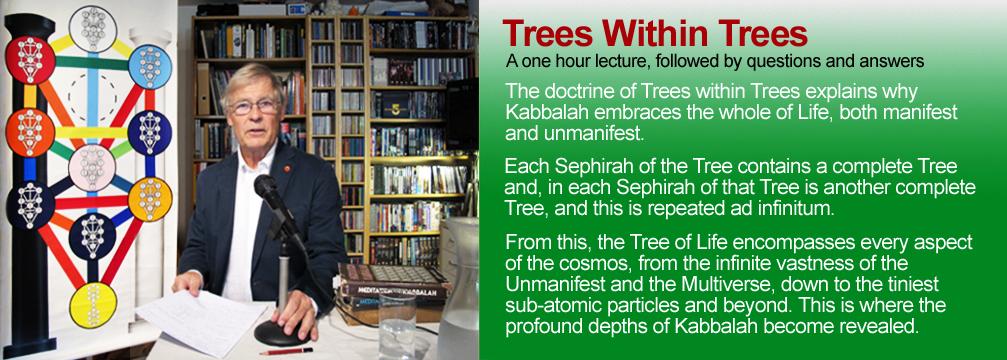International Order of Kabbalists - Advanced Courses and Specialsed Lectures |
 |

|
|
Trees Within Trees In this lecture, I will discuss the doctrine of Trees Within Trees. Understanding the symbolism of the embed trees gives us the ability to determine at what level (microcosm or macrocosm) the various aspects of reality are manifesting behind what we see as appearances. The Kabbalistic concept of "Trees within Trees" (Etzot b'Etzot) is a profound and intricate notion within Jewish mysticism, particularly within the teachings of Kabbalah. It symbolizes the interconnectedness of all aspects of existence, reflecting the idea that every phenomenon, entity, or concept is not only interconnected with others but also contains within itself numerous layers of meaning and symbolism. To delve into this concept, we must explore its origins, its implications, and its applications both in spiritual understanding and in our daily lives. Kabbalah, as a mystical tradition within Judaism, seeks to uncover the deeper, hidden meanings behind the Torah and the universe itself. One of its central motifs is the Tree of Life (Etz Chaim), a symbolic diagram representing the divine structure of the cosmos and the pathways through which divine energy flows. Within this Tree of Life, there are ten Sephirot, or emanations, each representing different aspects of God's attributes and the stages through which divine energy manifests. The concept of "Trees within Trees" builds upon this foundational structure by suggesting that each Sephirah, each divine attribute within the Tree of Life, contains within itself its own miniature Tree of Life. This fractal-like notion implies that the structure of creation is recursive and self-similar at various levels, echoing the mystical axiom "As above, so below. As within, so without" To grasp this concept more concretely, let us consider an example from everyday life: the concept of compassion. In Kabbalistic thought, compassion (Chesed) is one of the Sephirot on the Tree of Life, associated with overflowing kindness and benevolence. Within the Sephirah of Chesed, according to the concept of Trees within Trees, there exist smaller Trees of Life that represent compassion manifesting in different forms and contexts. For instance, a compassionate act towards a stranger might be seen as one branch within the larger Tree of Chesed. Within this act, there are further subtleties and nuances—perhaps the intention behind the act, the impact it has on both the giver and the receiver, and the ripple effects it creates in the surrounding community. Each of these aspects can be seen as smaller Trees of Life within the overarching concept of compassion, illustrating how one divine attribute contains within it multifaceted layers of meaning and application. Famous Kabbalists such as Rabbi Isaac Luria (the Ari) and Rabbi Moshe Chaim Luzzatto (Ramchal) have expounded upon the concept of Trees within Trees, providing insights into its metaphysical implications. Rabbi Isaac Luria, for instance, discussed the concept of Partzufim (Divine Faces), which are configurations of the Sephirot that interact and relate to each other in intricate ways, akin to nested Trees within the broader Tree of Life. According to Lurianic Kabbalah, each Partzuf represents a different configuration of the Sephirot, embodying unique spiritual qualities and divine attributes. The interactions between these Partzufim create a dynamic cosmic drama, where the flow of divine energy is continually manifesting and evolving through different levels of existence. Rabbi Moshe Chaim Luzzatto, in his works such as "Derech Hashem" (The Way of God), elaborates on the hierarchical structure of creation and the interconnections between different spiritual realms. He emphasizes the idea that every aspect of creation, from the highest spiritual worlds to the mundane physical realm, reflects the divine wisdom and purpose inherent in the Tree of Life. Practically, the concept of Trees within Trees encourages introspection and spiritual growth. It invites individuals to explore the interconnectedness of their thoughts, emotions, and actions, recognizing that each aspect of their being contains deeper layers of meaning and potential. By contemplating how divine attributes manifest within oneself and in the world, one can cultivate a deeper awareness of the spiritual dimensions of existence. Moreover, the concept underscores the unity of all creation, highlighting that everything is ultimately interconnected in the divine plan. This interconnectedness fosters a sense of responsibility and compassion towards others, as each individual's actions reverberate through the larger fabric of existence. In conclusion, the Kabbalistic concept of Trees within Trees is a profound philosophical and mystical notion that elucidates the intricate interconnectedness and layered meanings within creation. Drawing upon the symbolism of the Tree of Life and the insights of Kabbalistic masters, we can appreciate how this concept enriches our understanding of spiritual growth, cosmic unity, and the profound mysteries of existence. As we contemplate the nested structures of divine attributes within ourselves and in the world, we are reminded of the profound wisdom encapsulated in the words of the Kabbalists: "The world is built on kindness" (Pirkei Avot 1:2), reflecting the eternal truth that within every aspect of creation, there exists a divine spark waiting to be revealed. ==================================================================== To be continued... |







